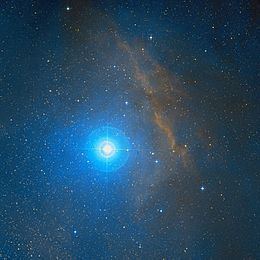Primary σ Sco A Magnitude 2.88 Apparent magnitude (V) 2.88 | Companion σ Sco B | |
 | ||
Luminosity 7004160000000000000♠(1.6±0.4)×10 L☉ Similar Delta Scorpii, Nu Scorpii, Xi Scorpii, Pi Scorpii, Kappa Scorpii | ||
Sigma Scorpii (σ Sco, σ Scorpii) is a star system in the constellation Scorpius. It has the traditional name Al Niyat, although this name is sometimes also applied to Tau Scorpii, or to the asterism formed by both Sigma and Tau. This system has a combined apparent visual magnitude of +2.88, making it one of the brighter members of the constellation, although greatly outshone by its neighbor Antares. Based upon parallax measurements made during the Hipparcos mission, the distance to Sigma Scorpii is roughly 696 light years (214 parsecs). North et al. (2007) computed a more accurate estimate of 7002568000000000000♠568+75
−59 light years (7002174000000000000♠174+23
−18 parsecs).
The brightest component of the system is a double-lined spectroscopic binary, which means that the pair has not been resolved using a telescope. Instead, their orbit is determined by changes in their combined spectrum caused by the Doppler shift. This indicates that the pair complete an orbit every 33.01 days and have an orbital eccentricity of 0.32.
The primary component of the spectroscopic binary, σ Scorpii A, is an evolved giant star with a stellar classification of B1 III. It has around 18 times the mass of the Sun and 12 times the Sun's radius. This star is radiating about 7004290000000000000♠29000 times the luminosity of the Sun from its outer envelope at an effective temperature of 7004261500000000000♠26150 K. This is a variable star of the Beta Cephei type, causing the apparent magnitude to vary between +2.86 and +2.94 with multiple periods of 6999246842900000000♠0.2468429, 6999239671000000000♠0.239671, and 8.2 days. During each pulsation cycle, the temperature of the star varies by 7003400000000000000♠4000±2000 K.
The other member of the core pair, σ Scorpii B, is a main sequence star with a classification of B1 V. Orbiting this binary at a separation half an arcsecond, or at least 120 Astronomical Units (AU), four times the Sun–Neptune distance, is the magnitude +5.2 σ Scorpii C, which has an orbital period of over a hundred years. Even farther out at 20 arcseconds, or more than 4500 AU, is σ Scorpii D with a magnitude of +8.7. It is classified as a B9 dwarf.
Given its position, youth, and space velocity, the Sigma Scorpii system is a likely member of the Gould Belt, and in particular the Upper Scorpius subgroup of the Scorpius-Centaurus Association (Sco OB2). Recent isochronal age estimates for the Sigma Scorpii system yield ages of 8–10 million years through comparison of the HR diagram positions for the stars to modern evolutionary tracks. This agrees well with mean age for the Upper Scorpius group which is approximately 11 million years.
Culture signification
The indigenous Boorong people of northwestern Victoria saw this star (together with τ Sco) as wives of Djuit (Antares).
